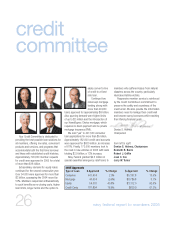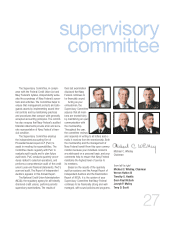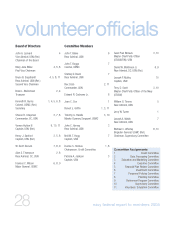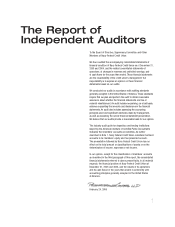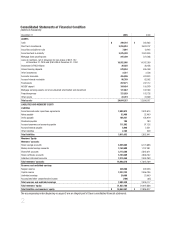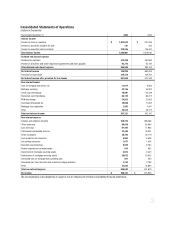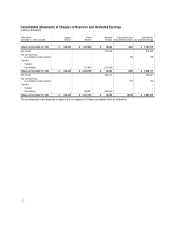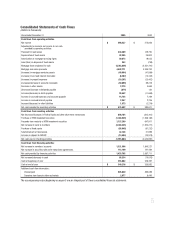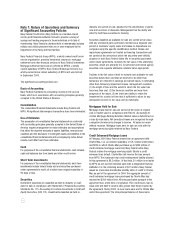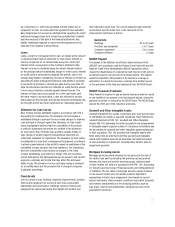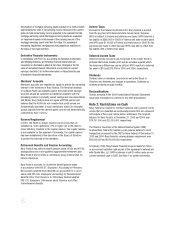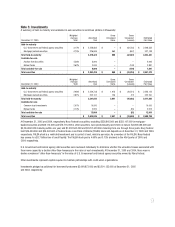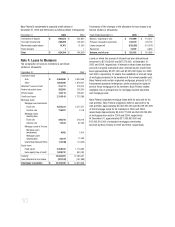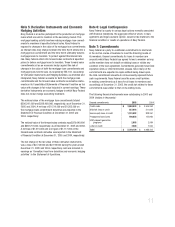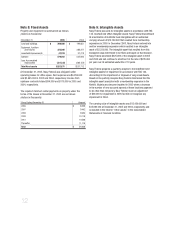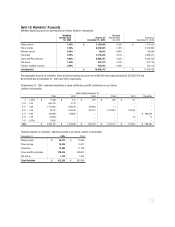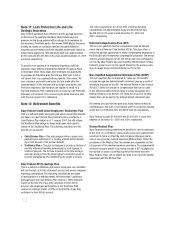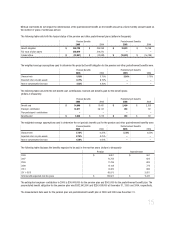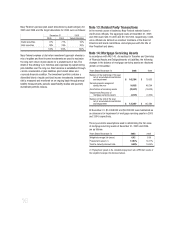Navy Federal Credit Union 2005 Annual Report Download - page 36
Download and view the complete annual report
Please find page 36 of the 2005 Navy Federal Credit Union annual report below. You can navigate through the pages in the report by either clicking on the pages listed below, or by using the keyword search tool below to find specific information within the annual report.
6
Note 1: Nature of Operations and Summary
of Significant Accounting Policies
Navy Federal Credit Union (Navy Federal) is a member-owned,
not-for-profit financial institution formed to provide a variety of
savings and lending programs to those individuals in its field of
membership. Navy Federal’s chartered field of membership includes
military and civilian personnel who are or were employed by the
Department of the Navy and their families.
Navy Federal Financial Group (NFFG), a wholly owned credit union
service organization, provides investment, insurance, mortgage
settlement and other financial services to Navy Federal’s members.
Mortgage settlement services are offered by NFRES, a wholly
owned subsidiary of NFFG. Navy Federal Brokerage Services is a
wholly owned broker dealer subsidiary of NFFG and was formed
in September 2005.
The significant accounting policies are:
Basis of Accounting
Navy Federal maintains its accounting records on the accrual
basis, which is in accordance with accounting principles generally
accepted in the United States of America.
Consolidation
The consolidated financial statements include Navy Federal and
NFFG. All significant intercompany transactions have been eliminated.
Use of Estimates
The preparation of consolidated financial statements in conformity
with accounting principles generally accepted in the United States of
America requires management to make estimates and assumptions
that affect the reported amounts of assets, liabilities, revenues and
expenses and the disclosure of contingent assets and liabilities in the
consolidated financial statements and accompanying notes. Actual
results could differ from those estimates.
Cash
For purposes of the consolidated financial statements, cash includes
cash and balances due from banks and other credit unions.
Short Term Investments
For purposes of the consolidated financial statements, short term
investments include federal funds sold and securities purchased
under agreements to resell, all of which have original maturities of
90 days or less.
Securities
Investment securities are classified as held-to-maturity or avail-
able-for-sale in compliance with Statement of Financial Accounting
Standards No. 115,
Accounting for Certain Investments in Debt and
Equity Securities,
(FAS 115). Investments classified as held-to-
maturity are carried at cost, adjusted for the amortization of premi-
ums and accretion of discounts. Management has the ability and
intent to hold these securities to maturity.
Securities classified as available-for-sale are carried at fair value,
with any unrealized gains and losses recorded as a separate com-
ponent of members’ equity. Gains and losses on dispositions are
computed using the specific identification method. Resale and
repurchase agreements are treated as financing transactions and
are carried at the amounts at which the securities were initially
acquired or sold. Navy Federal takes title to securities purchased
under resale agreements, monitors the fair value of the underlying
securities, which are primarily U.S. Government and federal agency
securities, and requests additional collateral when appropriate.
Declines in the fair value of held-to-maturity and available-for-sale
securities below their cost that are deemed to be other than
temporary are reflected in earnings as realized losses. In estimating
other-than-temporary impairment losses, management considers
(1) the length of time and the extent to which the fair value has
been less than cost, (2) the financial condition and near-term
prospects of the issuer, (3) the intent and ability to retain the
investment for a period of time that is sufficient to allow for any
anticipated recovery in fair value and (4) materiality.
Mortgages Held for Sale
Mortgage loans held for sale are carried at the lower of original
cost or market value in compliance with FAS 65,
Accounting for
Certain Mortgage Banking Activities.
Market value is determined on
a loan-by-loan basis. Net unrealized losses are recognized through
a valuation allowance by charges to income. All sales are made
without recourse. Mortgage loans held for sale are sold with the
mortgage servicing rights retained by Navy Federal.
Credit Enhanced Mortgage Loans
In February 2004, Navy Federal entered into an agreement with
Charlie Mac, LLC, an investor subsidiary of U.S. Central Credit Union,
and NFFG in which Charlie Mac purchases up to $200 million of
credit enhanced mortgage loans from Navy Federal while Navy
Federal retains the mortgage servicing rights. Should a credit
enhanced loan default, Charlie Mac will recover the loan amount
from NFFG. The maximum total credit enhancement liability allowed
in this agreement is $8.5 million. Of that total, $1 million is set aside
by NFFG as non-current restricted cash with a designated financial
institution. For the remaining amount of $7.5 million, Navy Federal
issued an irrevocable transferable standby letter of credit to Charlie
Mac as part of the agreement. In 2004, the aggregate amount of
credit enhanced mortgage loans purchased by Charlie Mac had
reached the $200 million limit. All loans purchased pursuant to the
agreement had, at the time of origination, FICO credit score, loan to
value ratio and debt to income ratio greater than those required by
the agreement. During 2005, no new loans were sold to Charlie Mac
under this agreement. The total principal balance of these loans




